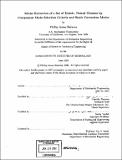| dc.contributor.advisor | Timothy Barrows and Samir Nayfeh. | en_US |
| dc.contributor.author | Balucan, Phillip James, 1977- | en_US |
| dc.contributor.other | Massachusetts Institute of Technology. Dept. of Mechanical Engineering. | en_US |
| dc.date.accessioned | 2005-06-02T15:34:02Z | |
| dc.date.available | 2005-06-02T15:34:02Z | |
| dc.date.copyright | 2001 | en_US |
| dc.date.issued | 2001 | en_US |
| dc.identifier.uri | http://hdl.handle.net/1721.1/17520 | |
| dc.description | Thesis (S.M.)--Massachusetts Institute of Technology, Dept. of Mechanical Engineering, 2001. | en_US |
| dc.description | Includes bibliographical references (p. 112-113). | en_US |
| dc.description.abstract | Model reduction techniques provide for a computationally inexpensive method for solving elastic dynamic problems with complex structures. The elastic nested gimbal problem is a problem which requires model reduction techniques as a means to reduce the dynamic equations. This is done using two methods: one technique employs mode ranking criteria to select modes which influence the dynamics of the problem the most. The second involves the use of static correction modes along with vibration modes to simulate the dynamics of this nested gimbal model. A model of the structure is described in terms of a lumped-parameter finite element model. This mathematical model of the physical system serves as the ha.sis for developing model reduction techniques for the nested gimbal problem. A truth model based on given initial conditions is used to compare the accuracy of the model reduced problem. A number of model reduction theories are described and applied to the gimbal simulation. The equations for the mode ranking techniques and the static and vibration mode analysis are developed as well as a quantitative error measure. Comparisons are made with the truth model using the mode ranking criteria base on the momentum coefficients and the frequency cutoff criteria. Test cases are also run using the static correction modes with vibration modes and static correction modes with the ranked vibration modes using momentum coefficients. The use of various static modes is discussed during the implementation of the static correction mode method. Applying the model reduction theories to a set of elastic, nested gimbals, the mode ranking criteria provides better results based on the error measure than the frequency cutoff criteria when the simulation is run using less than twenty-five modes. Using static modes along with ranked modes to represent the elastic dynamics of the problem does not provide better results than using the unranked vibration modes with the static modes. Modeling the dynamics using static correction modes with the unranked vibration modes provides the best results while using the lea.st number of modes. It is advantageous to take into account the given conditions applied to the system when reducing the model of a complex dynamic problem. | en_US |
| dc.description.statementofresponsibility | by Phillip James Balucan. | en_US |
| dc.format.extent | 113 p. | en_US |
| dc.format.extent | 3399355 bytes | |
| dc.format.extent | 3399164 bytes | |
| dc.format.mimetype | application/pdf | |
| dc.format.mimetype | application/pdf | |
| dc.language.iso | eng | en_US |
| dc.publisher | Massachusetts Institute of Technology | en_US |
| dc.rights | M.I.T. theses are protected by copyright. They may be viewed from this source for any purpose, but reproduction or distribution in any format is prohibited without written permission. See provided URL for inquiries about permission. | en_US |
| dc.rights.uri | http://dspace.mit.edu/handle/1721.1/7582 | |
| dc.subject | Mechanical Engineering. | en_US |
| dc.title | Model reduction of a set of elastic, nested gimbals by component mode selection criteria and static correction modes | en_US |
| dc.type | Thesis | en_US |
| dc.description.degree | S.M. | en_US |
| dc.contributor.department | Massachusetts Institute of Technology. Department of Mechanical Engineering | |
| dc.identifier.oclc | 49662383 | en_US |
